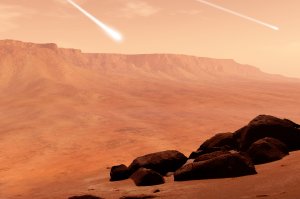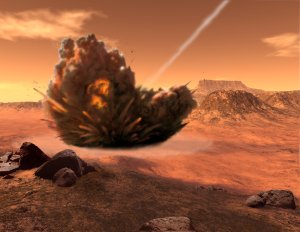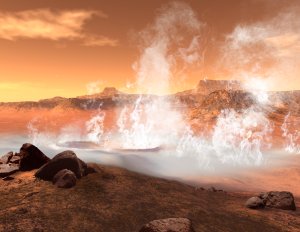Water-seeking THOR mission is NASA Mars finalist
"We can go places on Mars that are off-limits to other kinds of missions," says ASU planetary researcher.
TEMPE, Ariz. - "THOR," a mission to Mars developed at Arizona State University, has landed among three finalists in a NASA competition to select the next Mars Scout mission, set for launch in 2011. Philip Christensen of ASU's School of Earth and Space Exploration, in Tempe, is developing the mission in conjunction with the Jet Propulsion Laboratory in Pasadena, Calif. and Lockheed Martin Space Systems in Denver, Colo.
THOR, which stands for Tracing Habitability, Organics, and Resources, is designed to explore the present-day habitability of Mars in a way no other spacecraft can. In brief, THOR will target two impactors made of solid Arizona copper to strike carefully selected areas of Mars where scientists suspect water (as ice) lies only a few yards underground.
After the impacts, THOR will study the resulting craters and vapor plumes to assess the amount of water and organic compounds in the ground.

The two THOR impactors streak toward their targets in the mid-latitudes of Mars. Click on the image to download a larger version. (Image credit: Arizona State University/Ron Miller)
Martian Sweet Spot?
"The primary goal of THOR," explains Christensen, "is to get at the subsurface in the middle latitude regions of Mars." This refers to the zone of Mars between about 40 and 60 degrees latitude in both hemispheres. "This is where we think ice and liquid water could be present today." Christensen, who is Regents Professor of Geology, is the mission's Principal Investigator.
"Liquid water is key," he says. "And the mid-latitudes are where we believe snow and ice can accumulate - but it can also get warm enough for the ice to melt." It's a "Goldilocks" kind of place, he notes: "Not too cold, not too dry, but having just enough of the right properties to be habitable."
Christensen explains, "The equatorial regions we've explored in the past are currently warm but very dry, and the polar regions have lots of water, but they're extremely cold." The Martian middle latitudes appear to have the best of both, he says.
Findings released in December 2006 by a scientific team using the Mars Global Surveyor indicate that liquid water has flowed intermittently in some mid-latitude gullies during the last few years.
As Christensen notes, "We see mid-latitude mantles that might be snow, and other features that suggest ice and glaciers." All in all, he says, "lots of evidence points to liquid water or subsurface snow and ice at these latitudes."
Going Boldly Where Others Cannot
Engineering constraints have kept scientists from sending landers or rovers to such mid-latitude sites in the past. Many scientifically attractive sites lie at relatively high altitudes, or in terrain that is too rough to land on or drive across.
"We have a big advantage compared to rovers or stationary landers," grins Christensen. "We want to hit the ground going as fast as we can!"
This mission design offers THOR great variety of potential sites to examine in terrain that is rocky, hilly, or simply hazardous. "Looking for life, these might be the most exciting places we can explore," says Christensen. "And rovers have a hard time getting there."

One of the THOR impactors hits ice-rich ground, somewhere in the mid-latitudes of Mars. Click on the image to download a larger version. (Image credit: Arizona State University/Ron Miller)
Flight Plan
The mission plan calls for THOR to launch from the Kennedy Space Center in Florida, October 26, 2011. After a 10-month cruise to Mars, THOR arrives September 6, 2012. The primary science mission will last into January 2013.
The THOR spacecraft consists of an orbiter carrying a three-instrument payload, plus two impactors that weigh 1,200 and 450 kilograms (2,650 and 990 pounds) each. THOR releases the impactors separately about a week before it gets to Mars.
THOR's science payload includes THORIS (the THOR Infrared Spectrometer), which Christensen says will be the "most capable infrared spectrometer ever sent to Mars." THORIS will be developed at ASU in conjunction with the mission's industrial partners.
Also onboard are medium- and narrow-angle cameras developed by Malin Space Science Systems of San Diego. These operate in the visible and near-infrared part of the spectrum and will provide medium- and high-resolution views.
Arrive With a Bang
THOR's impactors will streak through the Martian atmosphere, taking 45 seconds to travel from the vacuum of space to the ground. Each will hit at 1:30 p.m. local time, traveling 5.3 km per second (12,000 miles per hour). "We're hoping to get down somewhere between 4 and 10 meters [13 to 33 feet] below the surface," says Christensen. The largest crater will be more than 35 meters (yards) wide.
The impact sites (yet to be selected) will lie roughly 200 kilometers (125 miles) apart, allowing different types of terrain to be targeted. At each site, the blast will expose to sunlight subsurface water ice and any organic compounds, causing them to sublimate, turning directly from ice into water vapor.
"Impactors are the easiest and most effective way to get beneath the surface," Christensen explains.

Subsurface ice, exposed to sunlight, boils off in clouds of water vapor, after one of THOR's two impactors has struck. The THOR orbiter will study the development of both craters after the impacts. Click on the image to download a larger version. (Image credit: Arizona State University/Ron Miller)
Inspection Tour
THOR will make its first observations of the craters about two hours after they form. This gives time for solar warmth to help subsurface ice raise a plume of water vapor. The spacecraft will study the sites at multiple infrared wavelengths using THORIS, while the two visible-light cameras record the scenes at high resolution and in color.
Then THOR fires its rocket engine to slow the spacecraft and let it be captured by Martian gravity into a two-hour orbit. The orbit's size ranges from 290 to 33,800 km (180 to 21,000 mi) above the surface. Every Martian day, THOR flies over the impact sites at an altitude of about 320 km (200 mi), recording the craters' growth as sunlight evaporates the impact-exposed water ice.
A few weeks after arrival, THOR will begin to use its spectrometer to measure trace gases in the atmosphere. These include methane, detected at very low levels by other Mars-orbiting spacecraft and from Earth. Methane, a potential byproduct of life, is a trace gas of great interest to Mars scientists. THOR will be able to resolve the current scientific debate over its presence, origin, and possible variations.
In addition, once each orbit, when THOR lies farthest from Mars, the medium-angle camera and spectrometer will snap whole-disk images of the planet. These will become an archive of Martian weather for meteorological studies.
Keep It Clean
THOR's impact approach provides an additional benefit for mission planners besides the "go-anywhere" design. Impactors are clean.
Explains Christensen, "The places that may have liquid water are special places where NASA is extremely cautious about sending landers. We don't want to contaminate potential Martian habitats with organisms from Earth. Any lander that went to one of these sites would have to be completely sterilized, which is hard to do."
But big solid-copper spheres are easy to sterilize, he notes. "And they also sterilize themselves as they come screaming through the atmosphere and heat up on the way in."
This means, says Christensen, "THOR can go places that are off-limits for rovers and other landers."












